
The Quantum3D Heavy Metal BX+ Iron System
Heavy Metal "IRON"- A low cost (compared to Mercury) PC hardware Image Generating based system for use as a software development platform or master system in conjunction with Mercury systems. Early Iron systems were advertised as being able to do selective edge anti-aliasing in software but in later press releases & PDF's it indicates Iron systems does no anti-aliasing. One can speculate the performance hit made it impractical or the software implementation was problematic.
As an aside, most people are not aware all 3dfx hardware can do selective edge anti-aliasing but there is a steep performance hit in the early hardware so for the most part it's use was avoided till the VSA-100 debuted. One application that did use the selective edge anti-aliasing was arcade games utilizing the Quantum3D AArdvark Banshee as most arcade applications are not very demanding.
The system below: What you are seeing is not an actual shipped system from Quantum3D but a system I built myself after reviewing the manuals & other literature from Quantum3D along with parts & input from 3 Quantum3D employees. The search for all the right bits & pieces was meticulous right down to having the correct knob on the case door & cast aluminum wingnuts retaining the plate over the drive bay! There are one or two details that are in question because no one at Quantum3D remembers or knows and will be noted along the way but they are very minor nitpicks.

One of the biggest reasons for wanting an Iron system was I was entranced with the idea of a 3dfx based system that could render a scene in three channels (left/center/right). With three Obsidian2 200SBi's on hand now all I needed now was the correct Quantum3D system to install them in. Not just any 3dfx card will do for multi-channel display, only Quantum3D boards with SwapLock capability will work. SwapLock synchronizes buffer swap and v-sync for every channel in a multi-channel Heavy Metal PC Image Generator (PCIG).
Other Iron optional graphics sub-systems include OEM Voodoo 3 PCI or Quantum3D Ventana Voodoo 3 along with single and dual 200SBi's of course.
General Iron options- According to the manuals, motherboard options were a single CPU Intel Seattle BX, a dual CPU Supermicro BX or a dual CPU Intel GX+. From a performance standpoint the dual PCI bus GX+ would be the fastest platform but both my Mercury system and AAlchemy system are so equipped. I toyed with the idea of a Seattle BX based Iron system but already have one of those (A very early Quantum3D demo system). I was able to obtain the correct Supermicro motherboard I settled upon from a member of the [H]ardOCP PC hardware forum. For CPU's a spare set of OEM P3-450's was installed (per the Quantum3D manual) along with 128MB of PC-100 ram. The floppy and CD-ROM drives are Sony or Toshiba as spec'ed in the manual and duplicates what came in my Mercury system.
Primary AGP display adapter- Choices ranged from Viper 550 TNT 16MB, ATI Rage Pro 8MB, Viper 770 TNT2 32MB to a Voodoo 3 16MB. The Voodoo 3 was automatically out of the running since it was listed as 2D & 3D display device in the manuals and finding the correct ATI Rage Pro among the gazillion variants sold by ATI was enough to give me a migraine. That left the two Diamond Viper cards and for two reasons the Viper 550 made the cut: The 550 was available & PCB dated in the time-frame I was working in and the Viper 550 disc and manual were shown in the Heavy Metal manual contents. Finding an original Viper 550 driver disc to include in the manual was a huge pain in the rear but worth the trouble.
Moving along to the network card, an Intel 10/100 PCI with 82557 chip was clearly listed in the manual and obtained from Ebay for a whopping $5, shipped.
An optional sound card was not installed as the only slots left available were ISA- While PCI sound cards are clearly listed as options the possibility of an installed ISA unit is more murky. The manual only states "Sound Blaster family" with a link to www.creative.com for driver updates. I erred on the side of caution and left a sound card out, though I would not be surprised if Quantum3D did ship systems with ISA sound boards. I have noticed the tech's at Quantum3D would install pretty much anything the customer wanted when ordering a system.
Finding the correct Quantum3D case caused much grief and took several months before I could obtain one, it's actually an conglomeration of four cases! The basic unit is from a Mercury system, but the back panel had to be swapped out (the Merc case has cutouts for the medusa cable connector and sync cables not required for an Iron system) and the motherboard tray had to be obtained and modified from another for proper motherboard fitment. Bits and pieces like the ATX backplate and drive bay blockoff plate came from a 4th donor. The power supply is a PC Power & Cooling ATX unit commonly used by Quantum3D and the case decals were done by a friend of mine using Mercury decals as a template. The door decal was reproduced using the only known picture of an Iron system as a guide and modified fonts from the Mercury case decals.
Nitpicks:
1) Quantum3D lists a 400 watt power supply as the entry level unit but I have seen other factory Quantum3D systems with less then 400. This might be an error in the manuals and literature or something as simple as the manuals and literature were updated as the systems became more powerful and we only have access to the latest revision manuals and literature. I'm keeping an eye on Ebay for a 400 watt unit from PC Power and Cooling and if one shows up, swap out the current 300 watt unit to be on the safe side.
2) The "Heavy Metal" decal on top of case- No one remembers if the BX+ systems came with a decal that stated just "BX" or "BX+" for now we went with the "BX+"
3) The "Intel inside" decal on the case door- For some reason there are some systems with them and some without. Since the Heavy Metal decal at the top has an "Intel inside" logo already I suspect that officially they didn't come with them. However I do have 3 factory systems here that do have the extra decal so techs assembling the system my have installed them at their discretion.
As one cheeky Quantum3D engineer opined after viewing the results: "Well its an Iron system all right, but all the dust is missing!"
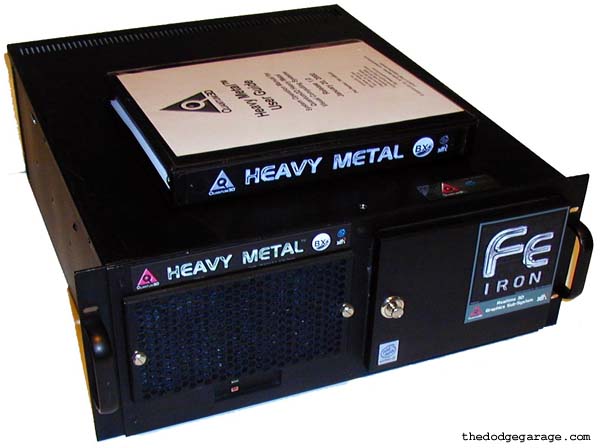
Quantum3D Heavy Metal BX+ 3 channel system in rackmount case.
Shot with cover removed showing internal cooling fans, board retaining bar, etc. (click for larger image in new window)
A shot from the rear with the card retaining bar removed (click for larger image in new window)
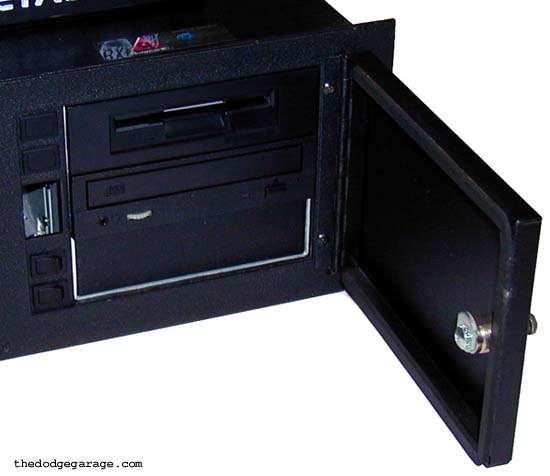
With the drive bay door open you can see the Sony floppy drive and Toshiba CD-ROM. At the bottom behind the block off plate resides the SCSI hard drive. While sorely tempted to install a Kingston SCSI drive carrier like the most of the Mercury systems have, I refrained from doing so. The Iron systems were a low cost alternative to Mercury and the bulk of them would not have had the optional carrier.
Another issue I had to ponder was hard drive- Standard on Iron systems was IDE, SCSI on Mercury. However word from a Quantum3D engineer is that they shipped a number of Merc' systems with IDE and a few Iron with SCSI. Since the Supermicro motherboard has an on-board Adaptec controller, this system has a Quantum SCSI drive.
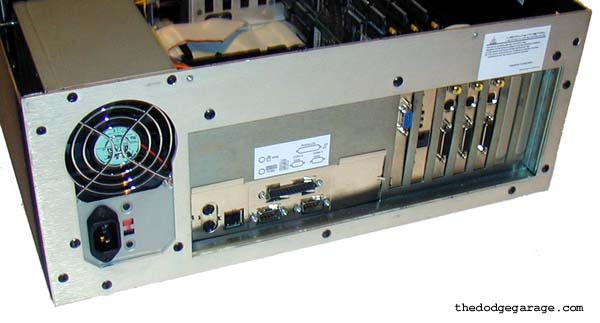
Rear of the system: The ATX motherboard backplate is correct for the system (included with case) as is the installation order of the PCI boards. I think the reason Quantum3D installed the network card where it is located was to keep heat from the Viper 550 AGP video card from cooking the Obsidian2 if installed in PCI slot one. The network card takes up less room and lets the AGP card get more airflow as well.
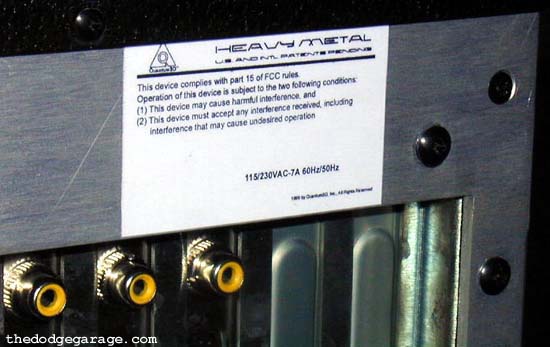
FCC label at the rear of the system.
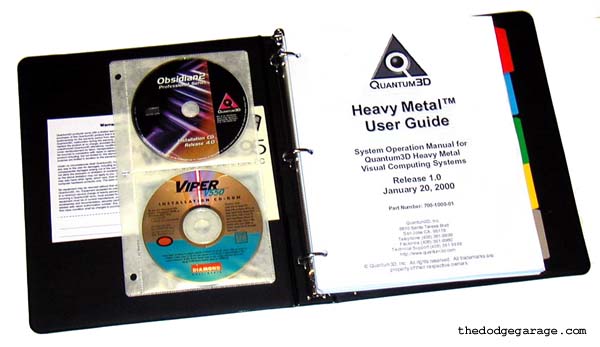
Quantum3D shipped the systems with a full array of manuals and system discs, I thought it would be a nice touch to duplicate.
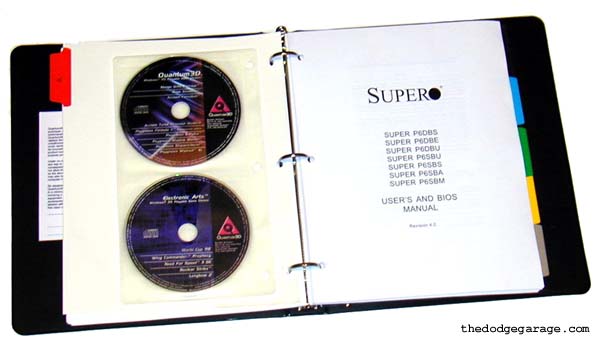
The manual contains operating system, driver & demo discs along with manuals & documents for the Viper 550, Intel network card, Supermicro motherboard and NT4 operating system.
To get an idea how a three channel system works here is a picture taken with my digital camera. Mind you these are three different monitors hence the colors are off between the three! Heck the center channel isn't even a CRT but an old Viewsonic LCD.
I cropped the screens out in Photoshop and placed them together so you can get a better idea how it looks. The scene above was generated by a Quantum3D OpenGVS demo flight program, I have not figured out just yet how to align the left channel better with the other two but will tinker with it in the future.